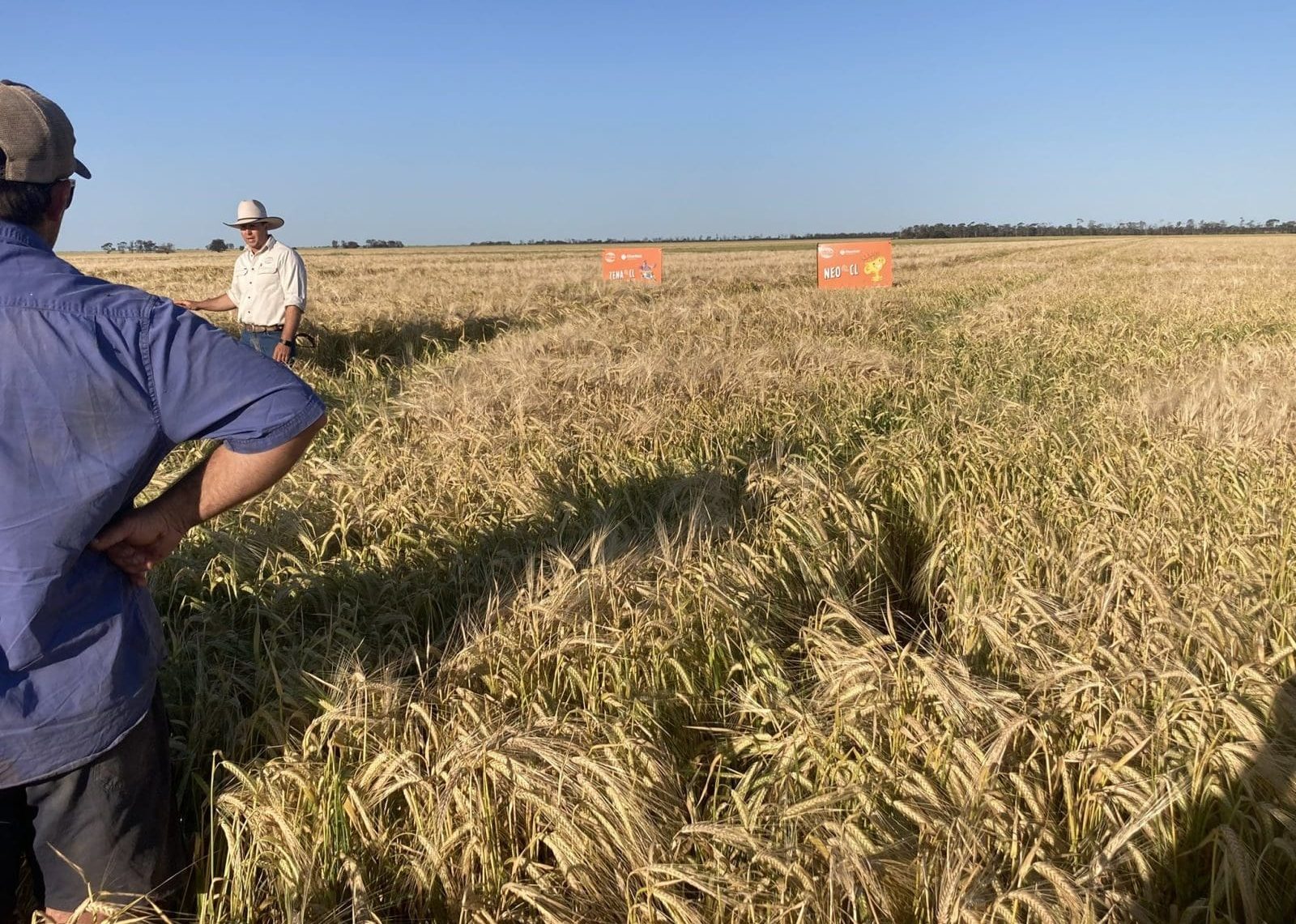
A barley crop walk at Croppa Creek in the far north of NSW in October, where yields were well above average and the crop enjoyed a mild finish. Photo: InterGrain
AUSTRALIA exported 1,094,612 tonnes of barley and 9932t of sorghum in January, according to the latest data from the Australian Bureau of Statistics.
The feed barley component of 505,548t was up slightly from the 496,335t shipped in December, while malting exports at 589,064t were more than triple the 179,282t shipped in December.
On sorghum, shipments have dwindled to a four-figure sum, down from 44,621t exported in December to mark the rundown on current-crop stocks in the closing quarter of the shipping year.
On feed barley, China on 293,882t was the major market by far, followed by Thailand on 100,606t, and Saudi Arabia on 64,930t.
China on 411,117t was also the biggest market for malting barley, followed by Mexico on 96,000t, followed by Vietnam on 35,335t, with South Africa not far behind on 30,000t.
Flexi Grain pool manager Sam Roache said December barley exports rose around 60pc from December, with excellent demand from a broad range of buyers meeting with aggressive selling from growers, especially in Western Australia, which has been powering the early program.
“The jump in export volumes is expected, as we can see it on shipping stems and have seen strong demand for a long time now, coming from a broad range of destinations,” Mr Roache said.
“China’s demand remains strong and is underpinning the export program, but its percentage share of our exports is remaining surprisingly low.”
“Both Thailand and Saudi Arabia have been taking volume feed barley shipments, which should continue.”
Mr Roache said Australian feed barley has been very well priced since late last year.
“Looking at the last months, our barley price relativities have only gotten better due to corn and feed wheat prices rallying strongly.
“We note consistent buying from the Middle East and Asia, along with Chinese demand continuing to improve, which indicates the strong demand and shipment pace will continue.”
Mr Roache said the outlook for malting exports was equally bright, with new business to Central America, Vietnam in recent months continuing to support overall volumes which remain underpinned by Chinese demand.
Indications from February and March stems are for around 1Mt per month of barley before volume drifts lower in April and May as stocks run down.
“We have a strong expectation that our export target will be 90pc complete by end May, leaving only 500,000t or so for June forward exports, a very tight figure.
“Demand remains strong, so likely price relativity will need to ration demand, which can come from lower EU-Black Sea pricing or higher Australian pricing , or both.
“We are seeing demand today for feed and malting barley right through April-June, which remains very supportive.”
Tariffs impact barley, sorghum
As US tariffs and retaliatory ones come into effect, Mr Roache said barley was moving into a stronger position in terms of feed demand, due to the high tariffs on US sorghum particularly.
Australia’s January sorghum stocks were seen as very low and logistics, and Qld and Newcastle shipping stems were heavy with chickpeas.
“February and March sorghum shipments will remain quiet, although they are likely to be above the January levels, before we see export volumes start to increase from late March.”
Mr Roache said Australian sorghum remains strongly bid.
“Recent questions over US tariff threats and Chinese retaliatory tariffs have added to our demand profile since last November.
“China’s recent retaliatory tariffs have already added 10pc, or nearly US$30/t, to the price of US sorghum, with the possibility of more to come.”
The US is traditionally the largest supplier of sorghum to China, shipping 5.7Mt last year, streets ahead of Australia in second place on around 2Mt.
“US sorghum exports to China also dwarf the Australian barley flow, making it the biggest unregulated feedgrain flow into the country, and therefore very hard to replace without additional wheat and corn import quota.
“This situation is currently highly favourable to Australian sorghum demand and, secondarily, barley demand, as it is also an unregulated feedgrain.”
| FEED | Nov | Dec | Jan | Tonnes |
| China | 553063 | 256106 | 293882 | 1103051 |
| Ecuador | 7301 | 0 | 6000 | 13301 |
| Hong Kong | 0 | 12 | 0 | 12 |
| Indonesia | 0 | 0 | 1060 | 1060 |
| Japan | 7700 | 66000 | 5000 | 78700 |
| Malaysia | 221 | 219 | 225 | 664 |
| New Caledonia | 153 | 160 | 306 | 618 |
| Papua New Guinea | 0 | 0 | 0 | 0 |
| Peru | 21299 | 0 | 24200 | 45499 |
| Philippines | 636 | 1140 | 1223 | 2999 |
| Saudi Arabia | 0 | 150000 | 64930 | 214930 |
| South Korea | 1159 | 657 | 1239 | 3055 |
| Taiwan | 2373 | 1295 | 2003 | 5672 |
| Thailand | 3550 | 4536 | 100606 | 108692 |
| UAE | 0 | 15000 | 0 | 15000 |
| Vietnam | 2982 | 1210 | 4873 | 9065 |
| TOTAL | 600437 | 496335 | 505548 | 1602319 |
Table 1: Australian feed barley exports for November and December 2024 and January 2025. Source: ABS
| MALTING | Nov | Dec | Jan | Tonnes |
| China | 192681 | 127211 | 411177 | 731069 |
| Japan | 0 | 0 | 12052 | 12052 |
| Mexico | 0 | 0 | 96000 | 96000 |
| Philippines | 440 | 1219 | 360 | 2019 |
| Singapore | 3683 | 1920 | 3469 | 9072 |
| South Africa | 0 | 46411 | 30000 | 76411 |
| South Korea | 640 | 159 | 160 | 959 |
| Taiwan | 529 | 0 | 0 | 529 |
| Thailand | 660 | 332 | 513 | 1504 |
| Vietnam | 34709 | 2029 | 35334 | 72071 |
| TOTAL | 233340 | 179282 | 589064 | 1001686 |
Table 2: Australian malting barley exports for November and December 2024 and January 2025. Source: ABS
| SORGHUM | Nov | Dec | Jan | Tonnes |
| China | 28233 | 10408 | 6093 | 44735 |
| Japan | 64 | 43 | 43 | 149 |
| Kenya | 0 | 29395 | 0 | 29395 |
| Philippines | 1114 | 1005 | 1968 | 4087 |
| Taiwan | 4264 | 3720 | 1827 | 9811 |
| Vietnam | 0 | 50 | 0 | 50 |
| TOTAL | 33675 | 44621 | 9932 | 88228 |
Table 3: Australian sorghum exports for November and December 2024 and January 2025. Source: ABS
Grain Central: Get our free news straight to your inbox – Click here

HAVE YOUR SAY